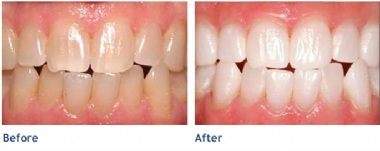Teeth Whitening

In-Office, Professional Teeth Whitening System: In-office whitening usually takes only one or two office visit to complete. It is considered to be reliable and effective and is great if you have an upcoming event that you would like your smile brightened for immediately. Examples include high school reunions, weddings, graduation photos or after quitting smoking. So if you’re too embarrassed to smile, have dark-stained teeth, or just simply want a whiter smile, the superiority of in-office whitening is just what you need. Your smile will be significantly whiter in one hour.
Take-Home Custom Tray Tooth Whitening Kits: Take-home teeth whitening kits are very effective and cost efficient. Using a lower concentration of carbamide peroxide to whiten your teeth than used in the office, you apply the gel onto a plastic tray that is designed to custom fit over your teeth. The gel-filled tray is then is worn every day as directed (usually for an hour or more) until the desired tooth whiteness is achieved. Although this type of tooth whitening kit doesn’t provide the instant results of the in-office treatment, you can continue to touch up your whitening from the comfort of your own home. You may purchase refills of carbamide peroxide to use with your custom trays in the future.
Reasons for Staining:
- Age: Normal wear and the accumulation of stains can darken the teeth and make you look older than you feel.
- Natural Tooth Color: Normal teeth can range in color from yellowish to grayish. If your natural tooth color is in the yellowish range, you are probably a good candidate for professional teeth whitening. Grayish teeth are more of a challenge, however, but are not impossible to whiten.
- Diet: Your diet is probably the biggest contributor to the tooth staining. If you regularly drink red wine, coffee, tea, cola, or other deep-colored beverages, they probably have affected the color of your teeth. Very acidic foods such as citrus fruit or vinegar are also culprits because they can make the surface of the tooth porous and allow more of the dentin to show through.
- Smoking: Smoking is one of the leading causes of brown stains. Nicotine can penetrate deep into the tooth and stain.
- Chemicals: Tetracycline, a commonly used antibiotic, causes grey stains if used during the formation of adult teeth. Tooth whitening is sometimes effective for Tetracycline stains and I usually try it before a more invasive procedure.
- Injury to the Teeth: Large cracks in teeth caused by trauma also are a cause of excessive staining. Teeth whitening techniques can be a great solution for these types of stains.
